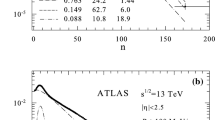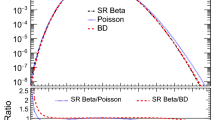Abstract
The multiplicity per rapidity of the well-identified particles \(\pi ^{-}\), \(\pi ^{+}\), \(k^{-}\), \(k^{+}\), \(\bar{p}\), p, and \(p-\bar{p}\) measured in different high-energy experiments, at energies ranging from 6.3 to 5500 GeV, is successfully compared with the Cosmic Ray Monte Carlo event generator. For these rapidity distributions, we introduce a theoretical approach based on fluctuations and correlations (Carruthers approach) and another one based on statistical thermal assumptions (hadron resonance gas approach). Both approaches are fitted to both sets of results deduced from experiments and simulations. We found that the Carruthers approach reproduces well the full range of multiplicity per rapidity for all produced particles, at the various energies, while the HRG approach fairly describes the results within a narrower rapidity range. While the Carruthers approach seems to match well with the Gaussian normal distribution, ingredients such as flow and interactions should be first incorporated in the HRG approach. We conclude that fluctuations, correlations, interactions, and flow, especially in the final state, assure that the produced particles become isotropically distributed.


Similar content being viewed by others
References
A N Tawfik Int. J. Mod. Phys. A29 1430021 (2014)
H Satz Rept. Prog. Phys. 63 1511 (2000)
B Muller Rep. Prog. Phys. 58 611 (1995)
E V Shuryak Phys. Rep. 61 71 (1980)
J Cleymans, K Redlich, H Satz and E Suhonen Z. Phys. C33 151 (1986)
J Cleymans and H Satz Z. Phys. C57 135 (1993)
H Kouno and F Takagi Z. Phys. C42 209 (1989)
A Andronic, P Braun-Munzinger, J Stachel and M Winn Phys. Lett. B718 80 (2012)
S K Tiwari, P K Srivastava and C P Singh J. Phys. G40 045102 (2013)
P K Srivastava and C P Singh Phys. Rev. D85 114016 (2012)
R Hagedorn and J Rafelski Phys. Lett. 97B 136 (1980)
L Marques, J Cleymans and A Deppman Phys. Rev. D91 054025 (2015)
S K Tiwari, P K Srivastava and C P Singh Phys. Rev. C85 014908 (2012)
J D Bjorken Phys. Rev. D27 140 (1983)
E Schnedermann and U W Heinz Phys. Rev. Lett. 69 2908 (1992)
E Schnedermann, J Sollfrank and U W Heinz Phys. Rev. C48 2462 (1993)
P Braun-Munzinger, J Stachel, J P Wessels and N Xu Phys. Lett. B365 1 (1996)
P Braun-Munzinger, J Stachel, J P Wessels and N Xu Phys. Lett. B344 43 (1995)
S Q Feng and Y Zhong Phys. Rev. C83 034908 (2011)
S Feng and X Yuan Sci. China G52 198 (2009)
S Uddin, J S Ahmad, W Bashir and R A Bhat J. Phys. G39 015012 (2012)
T Hirano, K Morita, S Muroya and C Nonaka Phys. Rev. C65 061902 (2002)
K Morita, S Muroya, C Nonaka and T Hirano Phys. Rev. C66 054904 (2002)
J Manninen, E L Bratkovskaya, W Cassing and O Linnyk Eur. Phys. J. C71 1615 (2011)
U Mayer and U W Heinz Phys. Rev. C56 439 (1997)
W Broniowski and W Florkowski Phys. Rev. Lett. 87 272302 (2001)
W Broniowski and W Florkowski Phys. Rev. C65 064905 (2002)
P Bozek Phys. Rev. C77 034911 (2008)
A N Tawfik, M A Wahab, H Yassin and H M N El Din J. Exp. Theor. Phys. 130 506 (2020)
H Yassin, E R A Elyazeed and A N Tawfik arXiv:2003.02675 [hep-ph]
A N Tawfik, M A Wahab, H Yassin and H N El Din J. Exp. Theor. Phys. 157 604 (2020)
F Becattini and J Cleymans J. Phys. G34 S959 (2007)
J Cleymans, J Strumpfer and L Turko Phys. Rev. C78 017901 (2008)
J H Lee et al BRAHMS (Collaboration) J. Phys. G30 S85 (2004)
S V Afanasiev et al (The NA49 Collaboration) Phys. Rev. C66 054902 (2002)
I G Bearden et al (NA44 Collaboration) Phys. Rev. C66 044907 (2002)
B Biedron and W Broniowski Phys. Rev. C75 054905 (2007)
E L Bratkovskaya, A Palmese, W Cassing, E Seifert, T Steinert and P Moreau J. Phys. Conf. Ser. 878 012018 (2017)
J Adams et al (STAR Collaboration) Phys. Rev. C70 041901 (2004)
W P Zhou, S H Cai and Z W Long Chin. Phys. C33 10 (2009)
K Hebeler, S K Bogner, R J Furnstahl, A Nogga and A Schwenk . C83 031301 (2011)
I G Bearden et al (BRAHMS Collaboration) Phys. Rev. Lett. 94 162301 (2005)
P Seyboth et al (NA49 Collaboration) Acta Phys. Polon. B36 565 (2005)
C Adler et al (STAR Collaboration) Phys. Rev. Lett. 87 262302 (2001)
K Adcox et al (PHENIX Collaboration) Phys. Rev. C69 024904 (2004)
N N Kalmykov, S S Ostapchenko and A I Pavlov Nucl. Phys. Proc. Suppl. 52 17 (1997)
N N Kalmykov and S S Ostapchenko Phys. Atom. Nucl. 56 346 (1993) [Yad. Fiz. 56 no 3 105 (1993)]
S Ostapchenko Phys. Rev. D74 014026 (2006)
S Ostapchenko Nucl. Phys. Proc. Suppl. 151 143 (2006)
S Ostapchenko AIP Conf. Proc. 928 118 (2007)
J Engel, T K Gaisser, T Stanev and P Lipari Phys. Rev. D46 5013 (1992)
R S Fletcher, T K Gaisser, P Lipari and T Stanev Phys. Rev. D50 5710 (1994)
E J Ahn, R Engel, T K Gaisser, P Lipari and T Stanev Phys. Rev. D80 094003 (2009)
K Werner, F M Liu and T Pierog Phys. Rev. C74 044902 (2006)
T Pierog and K Werner Nucl. Phys. Proc. Suppl. 196 102 (2009)
M Tanabashi et al (Particle Data Group) Phys. Rev. D98 030001 (2018)
S Capstick and N Isgur Phys. Rev. D34 2809 (1986) [AIP Conf. Proc. 132 267(1985)]
A N Tawfik, H Yassin and E R A Elyazeed (2019) arXiv:2003.02675 [hep-ph]
A N Tawfik Adv. High Energy Phys. 2019 4604608 (2019)
A N Tawfik and E Abbas Phys. Part. Nucl. Lett. 12 521 (2015)
P. Carruthers Proceedings of the XIII Warsaw symposium on Elementary Particle Physics p 317 (1990)
P Carruthers, H C Eggers, Q Gao and I Sarcevic Int. J. Mod. Phys. A6 3031 (1991)
J Randrup Acta Phys. Hung. A22 69 (2005)
T Pierog, I Karpenko, J M Katzy, E Yatsenko and K Werner Phys. Rev. C92 034906 (2015)
A Bazavov et al Phys. Rev. Lett. 113 072001 (2014)
P ManLo, M Marczenko, K Redlich and C Sasaki Eur. Phys. J. A52 235 (2016)
Acknowledgements
The work of AT was supported by the ExtreMe Matter Institute (EMMI) at the GSI Helmholtz Centre for Heavy Ion Research, Visiting Professor 2019.
Author information
Authors and Affiliations
Corresponding author
Additional information
Publisher's Note
Springer Nature remains neutral with regard to jurisdictional claims in published maps and institutional affiliations.
Appendix: Mathematical details for Eq. (6)
Appendix: Mathematical details for Eq. (6)
The Grand canonical partition function reads
where H is Hamiltonian of the system, N is the total number of constituents. In the HRG model, Eq. (27) can be expressed as a sum over all hadron resonances as
where ± stands for bosons and fermions, respectively, and \(\varepsilon _{i}=\left( p^{2}+m_{i}^{2}\right) ^{1/2}\) is the dispersion relation of the ith particle. The total number of particles can be obtained from the partition function as follows.
The invariant momentum spectrum of partially radiated by a thermal source is given by
where \(m_{T}\) is the transverse mass. This is given by
where \(p_{T}\) is the transverse momentum. The energy of the ith particle \(\varepsilon _{i}\) can be expressed in terms of the rapidity \(\left( y\right) \) and \(m_{T}\)
Then, the rapidity density can be obtained through integral over the full transverse mass \(m_{T}\),
To make the lower integration limit starts from zero, we define a new variable t
Equation (34) can be arranged as
By differentiating Eq. (35), we get
By substituting Eqs. (34), (35) and (36) into Eq. (33), we get
Also, Eq. (37) can be rewritten as
Let us define
Then, Eq. (38) can be rewritten as
Also, Eq. (40) can be rewritten as
The polylogarithmic function is defined as
where
By substituting from Eqs. (39), (42) and (43) into Eq. (41), we get
By substituting Eq. (39) into Eq. (44), the multiplicity per rapidity reads
Rights and permissions
About this article
Cite this article
Tawfik, A.N., Hanafy, M. & Scheinast, W. Multiplicity per rapidity in Carruthers and hadron resonance gas approaches. Indian J Phys 96, 2993–3005 (2022). https://doi.org/10.1007/s12648-021-02228-5
Received:
Accepted:
Published:
Issue Date:
DOI: https://doi.org/10.1007/s12648-021-02228-5




